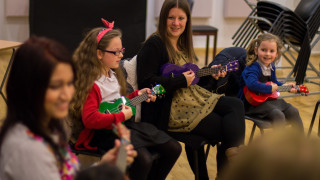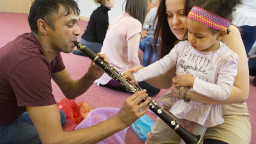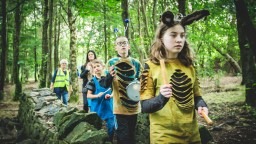Evaluation guidance - planning your project

Youth Music’s outcomes approach is built on the Charities Evaluation Services’ planning triangle, which is a useful tool for visualising the relationship between what your project is doing and why. The planning triangle represents your project on three levels: the overall aim, the intended outcomes, and the activities. As the figure shows, the overall aim sits at the top of the planning triangle. The intended outcomes sit beneath and support the overall aim, and the activities sit beneath and support the intended outcomes.
Since each level of the triangle is supported by the ones below it, this tool allows you to think about each level and how it relates to the others. For example, it allows you to check that your overall aim is supported by appropriate activities, and to explain to others how these activities will lead to your intended outcomes and, ultimately, your overall aim.
In this section, we will give examples of the process of completing the triangle step-by-step for two types of projects: a music-making project with children and young people, and a workforce/organisational development project.
Your project’s overall aim is why it exists and the long-term difference it wants to make, or its intended impact. It should address the key issue underlying the needs of your target group. In order to identify your project’s overall aim, ask yourself these three questions:
- Who is in your target group (e.g. their ages, location, challenging circumstances)?
- What is the key issue faced by your target group?
- What positive change will your project achieve for your target group on this issue?
While it is important to be ambitious with your project’s overall aim, it should be achievable. Make sure you have sense-checked what you are trying to achieve with the scope of your programme of work, ensuring your proposal is realistic within the limits of your funding request and project duration and organisational capacity.
Top tips for defining your overall aim
Your overall aim should describe the long-term change that it will achieve for your target group by using a verb that indicates the direction of change, e.g. ‘improve’, ‘increase’, ‘enhance’, ‘reduce’, ‘raise’, ‘strengthen’.
✗ To support young ex-offenders aged 18-25 in North London into employment
✓ To improve access to employment for ex-offenders aged 18-25 in Camden
Your overall aim should address a single key issue faced by your target group, rather than a number of smaller issues.
✗ To improve organisational capacity, support, and partnerships for delivering music-making activities in early years settings across the local area
✓ To improve the sustainability of music-making activities in early years settings across the local area
Your overall aim should be specific about your project’s target group, e.g. age, location, challenging circumstances.
✗ To improve the employability of young ex-offenders
✓ To improve access to employment for young ex-offenders aged 18-25 in Camden
Your overall aim should only describe what long-term change your project will make, not how it will work toward this aim.
✗ To improve the sustainability of music-making activities in early years settings across the local area through providing training and support for early years practitioners and senior leadership in these settings
✓ To improve the sustainability of music-making activities in early years settings across the local area
Example: Music-Making Project
Who is your target group? Young ex-offenders aged 18-25 in Camden
What is the key issue faced by your target group? Lack of access to employment
What positive change will your project aim to achieve for your target group in this area? To improve access to employment for young ex-offenders aged 18-25 in Camden
Example: Workforce/Organisational Development Project
Who is your target group? Early years settings in the local area
What is the key issue faced by your target group? Lack of long term music-making activities for early years children
What positive change will your project aim to achieve for your target group in this area? To improve the sustainability of music-making activities in early years settings across the local area
Your project’s intended outcomes are the changes in skills, knowledge, or behaviour that you predict will happen as a result of the activities delivered. To plan your intended outcomes, you first need to identify the barriers currently in the way of achieving your project’s overall aim. These barriers will usually be linked to the needs stemming from the key issue faced by your target group. Your outcomes are the specific positive changes that your project will aim to achieve for your target group in the short- to medium-term, which will support long-term progress toward your project’s overall aim. They should relate closely to the activities you intend to provide, be able to be described thoroughly using research methods, and be achievable and realistic within the time and resources attached to the project.
Youth Music’s outcomes framework defines the five broad areas of change that we support through our funding. These relate to musical, personal, and social outcomes for children and young people, and workforce and organisational outcomes (see below)
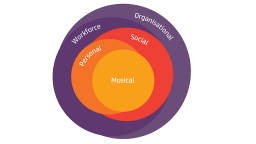
Musical outcomes
Musical outcomes are those relating to any aspect of musical development: this can include people’s musical skills, knowledge and abilities. Everyone has some level of musicality and we are looking for projects that build on this in a way that is appropriate for the participants. When working towards musical outcomes we want projects to be specific about which aspects of musicality they are looking to develop.
Personal outcomes
Personal outcomes are those relating to any aspect of personal development: this can include people’s skills, knowledge and abilities. Personal outcomes relate to how people feel about themselves, how they might be able to do things they weren’t able to before, or how they have developed their understanding of the world. This includes educational development and emotional development. Personal development is also strongly linked to social development and both are strongly linked to musical development.
Social outcomes
Social outcomes relate to changes in a person or group of people that can have broader benefits for people and society beyond the individual. Social outcomes can be based on changes in a person, or can be based on changes in communities or environments that relate to a person or group of people. Thinking about why positive cultural, health and educational experiences and outcomes which improve many people’s lives are so important to individuals also helps us to think about broader social outcomes.
Workforce outcomes
Workforce outcomes relate to the skills, knowledge and personal development of the workforce employed on a project. These aren’t direct changes in the young people you’re working with, but they add a great deal of value to the workforce and, by extension, the project and the participants. In all projects we would encourage you to think about the needs of the workforce and how to measure and evaluate their development.
Organisational outcomes
Organisational outcomes refer to either your own or another organisation and are to do with how well-equipped organisations are to help children and young people to develop in and through music, and to support the broader youth music sector. They might relate to an organisation’s ability to support children and young people, an organisation’s level of connectedness, or an organisation’s resilience to external changes. Organisational outcomes can also relate to organisational policies, procedures or cultures.
How do I know which outcomes to choose?
There are endless ways to bring about positive musical, personal and social development. The most important thing is to be appropriate to your participants’ needs and ensure that they have input into the project. Everyone will be on their own learning and progression journeys and you will be doing what you can to support their individual paths. That said, you will know from previous work and from consulting with participants which are the main areas of development you intend to focus on. This applies to outcomes relating to the workforce or organisations too. Think about where you and your colleagues are now, and where the evidence tells you that funding is needed to improve things.
How do I know whether outcomes are musical, personal, social, workforce or organisational?
We know there is a great deal of cross-over between outcomes – learning to play a musical instrument may increase confidence (and performing in front of others might change the perceptions of a community) – all of which needs to happen with the support of excellent practitioners and organisations. Setting and measuring outcomes is not an exact science, and the outcomes framework is designed to be flexible, but thinking clearly about the potential effects your activities will reveal just how many different outcomes you might achieve. This process is simply about structuring the work in a sensible and measurable way.
Top tips for identifying your intended outcomes
As with your overall aim, your intended outcomes should describe the short- to-medium term changes that it will achieve for your target group by using a verb that indicates the direction of change, e.g. ‘improve’, ‘increase’, ‘enhance’, ‘raise’, ‘strengthen’.
✗ To support young ex-offenders to apply for jobs
✓ To increase young ex-offenders’ confidence in applying for jobs
Your intended outcomes should focus on changes in skills, knowledge, or behaviour.
✗ To increase the number of partnerships between early years settings and local organisations that can support the sustainability of their offer
(Although this indicates the direction of change, it does not relate to a change in skills, knowledge, or behaviour. If you want to increase the number of partnerships, think about what change in skills, knowledge, or behaviour would help develop these partnerships.)
✓ To strengthen the relationship between the local Music Education Hub and early years settings
(This intended outcome supposes that a strong relationship between the hub and early years settings would help develop these partnerships.)
As with your overall aim, your intended outcomes should each address a single, specific change, rather than a group of related changes or a large, complex change.
✗ To increase young ex-offenders’ confidence in applying for jobs and improve their job-seeking skills
✓ To increase young ex-offenders’ confidence in applying for jobs
(In the above example, we have chosen to focus in on one of the two outcome areas. If both changes were considered critical to the project it would be worth cover them separately in two discrete outcomes.)
As with your overall aim, your intended outcomes should only describe what short- to medium-term changes your project will make, not how it will work toward these outcomes.
✗ To strengthen the relationship between the local Music Education Hub and early years settings through facilitating partnership-working
✓ To strengthen the relationship between the local Music Education Hub and early years settings
Your intended outcomes should link clearly to your project’s overall aim. To assess this link, ask yourself this question: if you achieve this outcome, will that bring you closer to achieving your overall aim?
Example: Music-making project
Overall aim: To improve access to employment for young ex-offenders aged 18-25 in Camden
What are the barriers to your overall aim?
- Young ex-offenders lack the skills that employers are seeking
- Young ex-offenders lack the confidence to apply for jobs
- Employers are hesitant to hire someone with a previous conviction
How will your project address these barriers?
- It will improve the employability skills of young ex-offenders
- It will increase young ex-offenders’ confidence in applying for jobs
- It will improve perceptions of candidates with a previous conviction among hiring managers in music-sector organisations
Intended outcome
- To improve the employability skills of young ex-offenders
- To increase young ex-offenders’ confidence in applying for jobs
- To improve perceptions of candidates with a previous conviction among hiring managers in music-sector organisations
Example: Workforce/organisational development project
Overall aim: To improve the sustainability of music-making activities in early-years settings across the local area
What are the barriers to your overall aim?
- Early-years practitioners lack the specialist skills needed to deliver music-making activities
- There is a lack of organisational support for music-making activities in early-years settings
- Early-years settings are not well-connected with local organisations that can support the sustainability of their music offer
How will your project address these barriers?
- It will improve early-years practitioners’ skills in delivering music-making activities
- It will increase support for music-making activities among senior leadership in early-years settings
- It will strengthen the relationship between the local Music Education Hub and early-years settings
Intended outcome
- To improve early-years practitioners’ skills in delivering music-making activities
- To increase support for music-making activities among senior leadership in early-years settings
- To strengthen the relationship between the local Music Education Hub and early-years settings
Note: As shown in the examples above, it is not necessary to repeat every detail about your target group in your intended outcomes, e.g. if you have already stated in your overall aim that you are working with young ex-offenders aged 18-25 in Camden, you can simply say ‘young ex-offenders’ in your intended outcomes, as it can be assumed that the other characteristics have not changed.
Your project’s activities are the work carried out in order to achieve its overall aim and intended outcomes. These activities typically lead to the production of outputs, the products or services delivered as part of the project (e.g. music-making sessions, music facilitator toolkits). While you use ‘change’ language for your outcomes (e.g. an improvement in employability skills), you should use ‘doing’ words for your activities (e.g. by providing traineeships).
It is crucial that each intended outcome is supported by at least one activity and each activity is linked to at least one outcome. This will give you a concrete plan for what you need to do to work toward your intended outcomes. If any of your planned activities aren’t linked to your intended outcomes, you need to consider why you’re delivering this activity and whether it should continue.
As part of our assessment process, Youth Music will consider how effectively your proposed activities will enable you to achieve your project’s overall aim and intended outcomes. The biggest oversight we tend to see in project planning is a lack of detailed consideration of how the activities will bring about the aim and outcomes. It’s important to consider what role different activities play within the project, as well as their order and priority.
Top tips for developing your activities
Your activities should describe what you will do by using a verb that indicates the delivery of an output, e.g. ‘provide’, ‘deliver’, ‘facilitate’, ‘offer’, ‘run’.
✗ To improve the offer of music administration and studio traineeships for young ex-offenders
✓ To provide music administration and studio management traineeships for young ex-offenders
Your activities should only describe what you will do, not what changes will result from these activities.
✗ To facilitate partnership working between hub partnerships and early years settings, strengthening these settings’ musical and creative networks
✓ To facilitate partnership working between hub partners and early years settings
Your activities should only describe work that relates to the production of project-specific outputs that will support progress toward the project’s overall aim and intended outcomes. They should not include broader organisational activities such as fundraising and evaluation.
Example: Music-Making Project
Overall aim: To improve access to employment for young ex-offenders aged 18-25 in Camden
Intended outcomes (what do you plan to achieve?)
- To improve the employability skills of young ex-offenders
- To increase young ex-offenders’ confidence in applying for jobs
- To improve perceptions of candidates with a previous conviction among hiring managers in music-sector organisations
Activities (what do you plan to do?)
- To provide music administration and studio management traineeships for young ex-offenders
- To deliver workshops for young ex-offenders on writing CVs and creating music portfolios
- To run awareness-raising events at music industry conferences
Example: Workforce/Organisational Development Project
Overall aim: To improve the sustainability of music-making activities in early-years settings in the local area
Intended outcomes (what do you plan to achieve?)
- To improve early years practitioners’ skills in delivering music-making activities
- To increase support for music-making activities among senior leadership in early years settings
- To strengthen the relationship between the local Music Education Hub and early years settings
Activities (what do you plan to do?)
- To provide mentorship and training for early years practitioners on delivering music-making activities
- To deliver an awareness-raising campaign about the value of early years music-making targeting senior leadership in early years settings
- To facilitate partnership-working between hub partners and early years settings
Reviewing your planning triangle
Once you have decided your project’s overall aim, intended outcomes, and activities, you should put them all together in your planning triangle and review it to make sure it fits together logically. You can find completed planning triangles below for the example music-making project and example workforce/organisational development project:
Planning triangle for the example music-making project
Planning triangle for the example workforce/organisational development project
With this completed visual representation of your project, you can quickly and easily see how different parts of your project relate to the whole and explain it to others. If you follow all of the top tips on defining your overall aim, defining your intended outcomes, and developing your activities, you’ll have a robust project plan, increasing the likelihood of successfully addressing the needs of your target group.
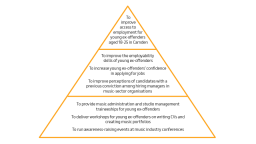
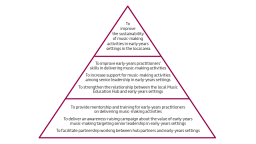
With this completed visual representation of your project, you can quickly and easily see how different parts of your project relate to the whole and explain it to others. If you follow all of the top tips on defining your overall aim, defining your intended outcomes, and developing your activities, you’ll have a robust project plan, increasing the likelihood of successfully addressing the needs of your target group.
- Your project’s activities are the work carried out in order to achieve its intended outcomes. In turn, your project’s intended outcomes are the changes in skills, knowledge, or behaviour needed to overcome the barriers to achieving your project’s overall aim.
- Using the planning triangle tool will help you to understand how your intended outcomes and activities will support the overall aim of your project.
- Using existing statistics, research and dialogue with potential participants will help you to evidence and articulate the need for your project.

